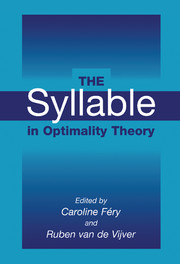Book contents
- Frontmatter
- Contents
- List of Contributors
- Preface
- The Syllable in Optimality Theory
- Part One INTRODUCTION
- Part Two SYLLABLE STRUCTURE AND PROSODIC STRUCTURE
- Part Three NONMORAIC SYLLABLES AND SYLLABLE EDGES
- 6 Syllables and Moras in Arabic
- 7 Semisyllables and Universal Syllabification
- 8 Onsets and Nonmoraic Syllables in German
- 9 Extrasyllabic Consonants and Onset Well-Formedness
- 10 Beyond Codas: Word and Phrase-Final Alignment
- Part Four SEGMENTS AND SYLLABLES
- Part Five HOW CONCRETE IS PHONOTACTICS?
- Author Index
- Languages Index
- Subject Index
6 - Syllables and Moras in Arabic
Published online by Cambridge University Press: 03 July 2009
- Frontmatter
- Contents
- List of Contributors
- Preface
- The Syllable in Optimality Theory
- Part One INTRODUCTION
- Part Two SYLLABLE STRUCTURE AND PROSODIC STRUCTURE
- Part Three NONMORAIC SYLLABLES AND SYLLABLE EDGES
- 6 Syllables and Moras in Arabic
- 7 Semisyllables and Universal Syllabification
- 8 Onsets and Nonmoraic Syllables in German
- 9 Extrasyllabic Consonants and Onset Well-Formedness
- 10 Beyond Codas: Word and Phrase-Final Alignment
- Part Four SEGMENTS AND SYLLABLES
- Part Five HOW CONCRETE IS PHONOTACTICS?
- Author Index
- Languages Index
- Subject Index
Summary
CV-, VC-, and C-dialects
Some of the most salient differences among Arabic vernaculars have to do with syllable structure. This study focuses on the syllabification patterns of three dialect groups, (1) VC-dialects, (2) C-dialects, and (3) CV-dialects, and argues that they differ in the licensing of semisyllables, moras unaffiliated with syllables and adjoined to higher prosodic constituents. The analysis provides some evidence for a constraint-based version of Lexical Phonology, which treats word phonology and sentence phonology as distinct constraint systems that interact in serial fashion.
VC-dialects include the dialects of Syria, Lebanon, Palestine, Iraq, and Turkey (Blanc 1953, Erwin 1963, Cowell 1964, Grotzfeld 1965, Palva 1966, Jastrow 1978, Behnstedt 1994), Bedouin and Bedouin-type dialects, such as Bani-Hassan of Jordan (Irshied and Kenstowicz 1984), the Hijazi dialects of Central Arabia (Jastrow 1980a), and the dialects of eastern Libya (Owens 1984: 12ff., Mitchell 1993: 85, 88), and two groups of Egyptian dialects, spoken in the easternmost part of the Delta and in Upper Egypt approximately to Asyuṭ. (Woidich 1980: 207, Behnstedt and Woidich 1985).
C-dialects are spoken over a large area in North Africa, including Morocco (Harrell 1962a, 1962b, 1965), Tunis (Marçais 1977: 28, Singer 1980), and Mauretania (Cohen 1963). Like the coterritorial Berber (Dell and Elmedlaoui 1985, 1988, 1996a, 1996b, 1997, Dell and Tangi 1992, 1993, Prince and Smolensky 1993, Clements 1997), they have long consonant sequences, which have been analyzed both as complex clusters and as sequences of syllables with consonantal nuclei.
- Type
- Chapter
- Information
- The Syllable in Optimality Theory , pp. 147 - 182Publisher: Cambridge University PressPrint publication year: 2003
- 53
- Cited by



